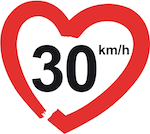About 30km/h (20mph)
Speed limits of 30km/h (20mph) save lives. Since the first 30km/h zone was started as a pilot project in the small German town of Buxtehude in 1983, numerous 20-mph zones throughout Europe have proven their worth. Wherever these zones come in, the number and the severity of accidents is reduced considerably.
A limit of 30km/h (20 mph) in all residential areas improves air quality, as far fewer exhaust gases are emitted, making an important contribution to public health.
The 30km/h (20 mph) limit in all residential areas helps combat climate change, as a lower speed means less CO² emissions. And it ensures a more constant traffic flow with less congestion and traffic jams and makes cycling, walking and using the bus or train much more enjoyable. This encourages traffic reduction, and so brings an even greater benefit in terms of less greenhouse gas emissions. What is really important for us too is that these effects will automatically help decrease the oil dependency of the European Union.
Limiting vehicles to 30kmh (20 mph) reduces traffic noise by up to 40% (3 dbA), which makes a real difference.
A calmer culture in the whole town encourages manufacturers to adapt car engines to suit a more easy-going driving style instead of just striving for fast acceleration.
Our goal: 30 km/h (20mph) as the standard European speed limit for residential areas – and no longer limited to single zones.
The EU population will benefit. However, children, old people and those with disabilities will benefit in particular, as well as those who can only afford cheaper housing, which is often along main roads outside of any 30km/h (20 mph) zone.
Up to now, there have been strict legal limitations on any administration wanting to establish a 30km/h (20 mph) zone. Also, it is obvious that many people simply do not respect the zones as the standard 50km/h (30 mph) limit is what they are used to. Or they just don’t see the signs. Therefore, local governments are forced to invest in expensive measures when they want to introduce traffic-calming schemes. However, a standard speed limit for the whole town would make the regulations very clear and also save them considerable expense and time.
Additionally, the positive effects on health and the environment would increase and the external costs of transport would fall.
Read more detailed information on
3 Comments
Trackbacks/Pingbacks
- 13 ideas to improve Northern Ireland cycling in 2013 « Northern Ireland Greenways - [...] Ireland into line with the developing movement across Europe for safer residential streets. Existing 20mph/30kph zones demonstrate the benefits…
- The 30 Km/h Zone | Winnipeg's Sidewalks & Crosswalks - […] http://en.30kmh.eu/why-30kmh-20-mph/ […]
- 13 ideas to improve Northern Ireland cycling in 2013 | Northern Ireland Greenways - […] Ireland into line with the developing movement across Europe for safer residential streets. Existing 20mph/30kph zones demonstrate the benefits…



30km/h ?????? Only deutchland ost europa no
Whilst I’m 100% behind you on the safety and social reasons for a 30 km/h limit, promoting it as a vehicle to significantly reduce emissions is leading people up the wrong path.
In town driving, the correct gear selection will reduce or optimize the engine speed (and emissions) for the desired road speed. This is only a general statement but I would suggest that the emissions argument is more apparent on motorways where the vehicle is in top gear – Engine speed then has a more direct linear relationship with road speed and emissions..?
‘Wherever these zones come in, the number and the severity of accidents is reduced considerably.’
For many years, police forces and emergency services around the globe have been trying to get the public to understand that there is no such thing as an ‘accident’ when it comes to death and injury caused by motor vehicles. For example, QPS here in Queensland, Australia, have not used the term ‘accident’ for many years. Instead, they use the term ‘incident’.
In a relatively small number of incidents, faulty vehicle design, incorrect or inadequate maintenance is the direct cause of a car crash. In most cases, however, a car crash is the result of carelessness, negligence or recklessness on the part of the driver. Often, the driver is intoxicated by alcohol or other drugs. They may be sleep deprived. Their vision may be faulty.
Texting, chatting to passengers, eating, drinking: all things that distract the driver’s attention from the road are other causes. In every case, the driver is at fault. The driver is to blame for failing to keep a proper lookout, for driving without all due care and attention
Yes, apologists for the human condition prefer the term ‘accident’ and get irate at the suggestion that each of us should be held to account for our actions. The more indignant, the more likely such apologists are to have caused serious injury by their past negligence, and to do so again in the future.